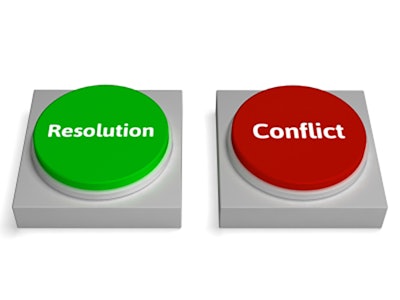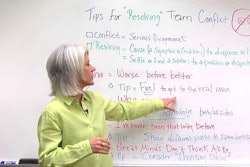
While conflict is quite normal for construction crews it does not mean that we as leaders should not address the conflict and look for positive and proactive means to resolve conflict. Certainly conflict within any project team, construction crew or any internal department should be viewed as “when it happens” versus “if conflict happens.” You place people into a focused area and you will have conflict!
It’s inevitable. A seasoned superintendent, an impatient foreman and a “know-it-all” project manager begin heated discussions on the best approach that will give their project a jump ahead of the schedule but will also incur more cost than was budgeted. Words are thrown out initially to first defend a particular position or relate some past experience but the words quickly get heated and are soon misinterpreted as “incoming!”
Within just a few minutes these three field leaders are moved almost to a physical altercation. The superintendent storms out of the trailer (after kicking over the water cooler), the project manager heads back to his room to email his latest complaint about the situation, and the foreman finishes his cold cup of coffee and eases on back to his crew convinced that he is the only right thinking leader on the job.
This scenario is repeated hundreds of times a day on construction sites across the country. Whether your construction company builds mammoth hospitals or whether you operate a small specialty trade flatwork business the same potential for conflict exists. But how do we resolve such a conflict that can damage relationships, sabotage performance and leave fewer profits in the end?
Conflict must first be understood before it can be resolved. Briefly, conflict is inherent in any work environment where there is more than one individual at work. It’s just human nature to consider personal preference over the opinion of others. In the construction industry there is no shortage of workers and leaders who feel that their way of performing, making decisions or addressing other individuals is superior. It takes a willingness to listen to the “other side” to prevent conflict, resolve differences and, most importantly, produce quality, safe and profitable work.
So, what is the source of most conflict among the members of a project team? Generally speaking, most conflict begins when there is a difference between two opposing points of views. The opposing views might be based on different opinions or they might be based on different interpretations of some single source such as the interpretation of a drawing, a budget, a procedure or a regulation. No matter the source a conflict develops when there are differences. It’s natural and is part of every construction company.
Before we review some solid conflict resolution techniques, let’s be fair to the topic of conflict. Not all conflict is bad. In fact, if the two “parties” engaged in the conflict are mature, much improvement can come out of diverse opinions and experience. It would be fair to say that many of the best solutions on most construction sites, among even the most emotional of crews, probably came as a result of some momentary conflict.
Now, let’s consider key steps to resolving conflict.
- First, recognize that conflict is normal.
- Seek to understand the “root” of the difference.
- Strive to keep cool heads from heating up.
- Consider personal “baggage” that some individuals might be carrying.
- Remind those involved of the desired business result.
- Brainstorm for possible solutions that support reaching the desired result.
- When necessary be very clear about the “non-negotiables.”
- Come to an agreement, without pulling rank if possible.
- If agreement is reached, follow up with the project members in conflict to test the adjustment.
- If agreement is not amicably reached, senior leader makes decision and communicates needed action to involved individuals.
Let’s briefly address each of the steps.
First, recognize that conflict is normal. Conflict is as natural to construction employees as breathing. Remember, not all conflict is bad! Build a company culture that values different opinions, that seeks better solutions and that respects individuals even when some might disagree with their position, opinion or suggestion. Such a culture will expand from time to time due to the energy but if led proactively can leverage the company for better days.
Seek to understand the “root” of the difference. Conflict often arises due to misunderstandings. Always get clarity on the issue at hand. Seek to get to the real root of the conflict; allow the different parties the time to fully explain their perspective.
Work to have both parties come to an agreement as to what the root issue is that is causing the conflict. This can be challenging to reach but it is key to preventing conflict being based on hearsay and “I thought this” rather than the bonafide root cause.
Strive to keep cool heads from heating up. Cool heads typically come to resolution sooner, and that means less time is wasted on disagreeing. If “temperature” is rising, call a time-out and separate for a short time before reconvening. Bring a little humor into the situation without making fun of those who are in conflict.
Remind everyone that feeling passionate about one’s opinion or experience is great BUT that the best interest of the customer and his own company is what is paramount.
Consider personal “baggage” that some individuals may be carrying. Some folks simply can’t let go of past wrongs done to them or some past negative experience that they have harbored. Considering a person’s “baggage” doesn’t mean not holding individuals accountable but it often explains why some folks take a particularly negative approach or position that can contribute to conflict.
If you have one project member invoking some “baggage” that he feels the other member has, be quick to address and correct such thinking. Again, if the conflict resolution effort allows for personal bias to interfere it might be very difficult, perhaps impossible, to come to any worthwhile compromise.
Remind those involved with the conflict of the desired business result. When conflict happens many individuals become self-serving. It is very critical to remind those involved, if necessary, that “it’s not about them.” The ultimate result must achieve the desired business result even if it means that one or more parties must give up something.
This step must clearly convey that construction is a business and as a result not everyone gets his way all the time. Setting goals for the project with measurable indicators early in the project’s life can help later to remind each project member where his focus needs to be and what counts in the end.
Brainstorm for possible solutions that support reaching the desired result. Eventually the conflict parties must brainstorm for possible solutions. The effort here must stay focused again on the desired business result: “What is the best decision for this situation?”
Likewise, when the brainstorming begins it is important that everyone realizes that when brainstorming there is no such thing as a “bad idea.” If others quickly begin to dissect a brainstormed suggestion then it will be quite likely that the brainstorming effort will fail.
When necessary be very clear about the “non-negotiables.” There is little reason to get all chaffed about what cannot be changed. For example, continuing conflict over federal, state or city standards makes little sense. So on any construction project where there is conflict make sure to clearly communicate whatever the “non-negotiables” are and make sure the people involved recognize them.
Come to an agreement, without pulling rank if possible. If the conflict is between a superintendent and roreman the temptation might be to have the superintendent pull rank on the foreman, thus adding “fuel” to the conflict. While a Superintendent might very well have to make a decision not liked or agreed to by the foreman, it is always better to have those in conflict, no matter their rank and relationship to each other, come to a mutual resolution. “Rank pulling” often leaves one party the “loser” and looking to get revenge.
If agreement is reached, follow-up with the project members in conflict to test the adjustment. Whenever agreement is reached it is wise to follow-up with those project members involved to see how they are adjusting to the resolution and what issues might still exist. Following-up also reinforces to both parties that the conflict, although uncomfortable, produced a better-than-expected result.
If agreement is not amicably reached, senior leader makes decision and communicates needed action to involved individuals. While this step is not desired it might represent reality. If the conflict must be resolved by a “higher power,” the senior leader had better be very clear about what is expected and what the consequences will be if a resolution is not supported or maintained. This is the least-desirable option, but at times it might be the only option that can be taken.
I’ve tried to present some additional ways to resolve conflict that might not always be formally taught. While conflict is definitely uncomfortable for many construction leaders, it is important that you learn how to redirect the creative juices that often accompany such conflict and search for better solutions.



















